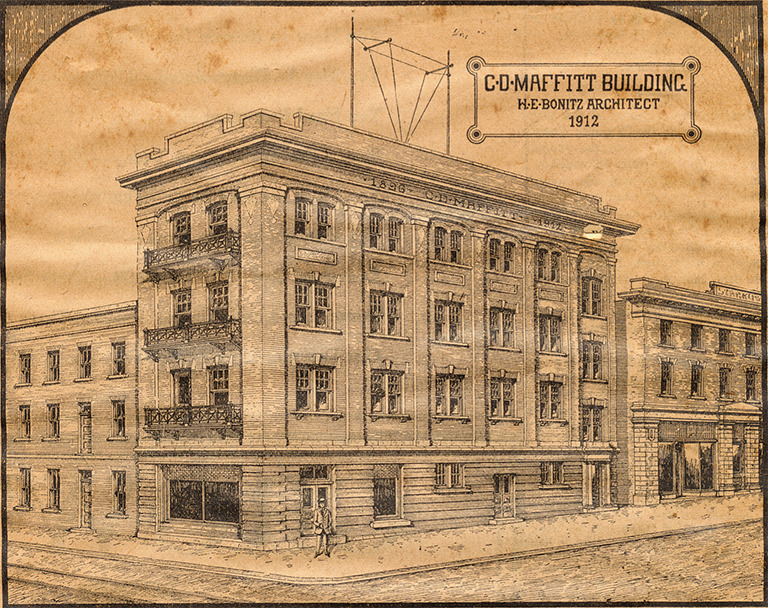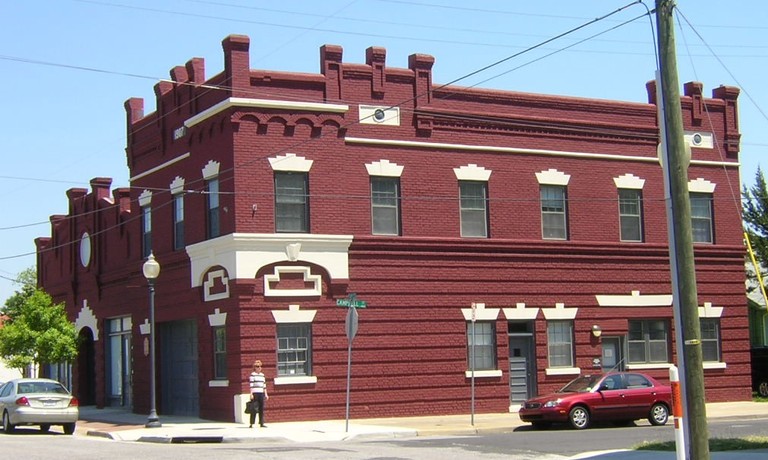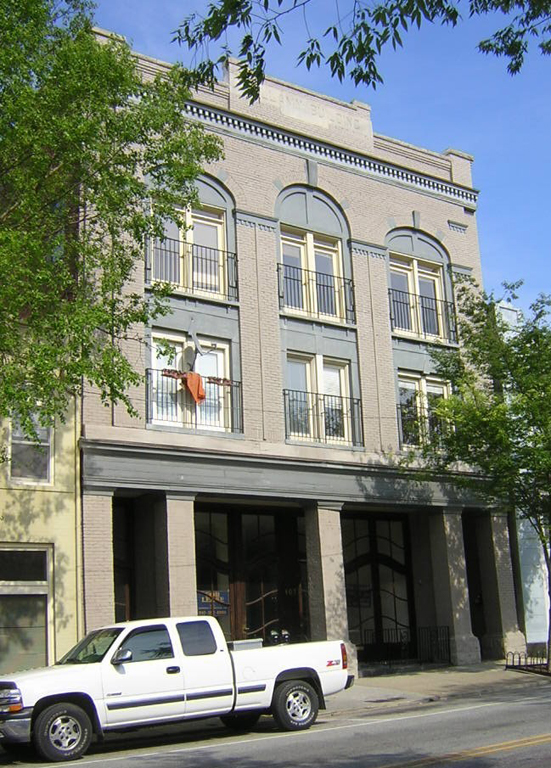Brady, Robert H. (1859-1936)
Variant Name(s):
R. H. Brady; Robert Henderson Brady
Birthplace:
Fayetteville, NC
Trades:
- Brickmason
- Contractor
NC Work Locations:
Building Types:
Styles & Forms:
Italianate; Neoclassical
Robert H. (R. H.) Brady (1859-1936) was a brickmason and contractor active in Wilmington for many years. He is representative of the many builders who began as artisans and emerged as prominent contractors in the late 19th and early 20th centuries. His work included renovations, additions, and new buildings, including notable downtown buildings designed by leading local architects such as Henry E. Bonitz, James B. Lynch, and Charles McMillen.
Robert H. Brady was born in Fayetteville, a son of Sarah Lockamy Brady and James Brady. His father died when Robert was young, possibly in the Civil War. In 1870 Robert’s widowed mother Sarah, who worked as a seamstress, headed a household in Wilmington that included Robert and his three brothers. Robert’s training in the brickmason’s trade has not been recorded, but it is likely that as an “orphan” (as children without living fathers were often identified), he was apprenticed to a local master of the trade. In 1880 at age 21, he was living with his mother and identified as a brickmason. In 1884 at age 24 Robert married Willie Fidelia Wallace, aged 19 and also a resident of Wilmington. In 1900, the census listed R. H. Brady as a brickmason aged 40, residing with his wife, Willie F., on Church Street in Wilmington. The couple had five children.
By 1895 Brady had moved into the ranks of contractors: the Wilmington Messenger of July 4, 1895, cited him as “the well known contractor” who was repairing French and Son’s building and building a new front to replace one that burned, and Brady advertised in the Wilmington Dispatch of July 6, 1895, as a contractor and bricklayer “thoroughly competent to take contracts and do all kinds of work in the bricklayers’ line. Give me a trial.” His work included renovations, repairs, and additions at several prestigious buildings, including the New Hanover County Courthouse and First Baptist Church.
The Wilmington Morning Star of February 21, 1899 carried a report on the efforts of the Wilmington Labor Bureau and the White Laborers’ Union to “establish all deserving white men in paying positions.” The report included a list of (white) “skilled laborers” interested in finding employment. Among these was brickmason R. H. Brady. This action followed upon the 1898 coup in Wilmington organized as part of the statewide “white supremacist” crusade; after seizing control of political power, certain white leaders took economic measures such as this to restrict promote white workers’ interests and restrict those of black workers. Despite the restrictions of Jim Crow practices in the early 20th century, the Wilmington Morning Star of April 10, 1901 reported without comment that contractor R. H. Brady was working with a “force of negro laborers” excavating for a building project.
During the early years of the 20th century, Brady continued to take contracts for renovations and additions, including remodeling St. John’s Masonic Hall in 1907. Most notably, he built several new buildings downtown from designs of leading local architects, including the Consolidated Market and Fire Engine House No. 3 (Wilmington Messenger, June 30, 1907); J. W. Plummer, Jr.’s new confectionary shop (Wilmington Messenger, March 7, 1907); the Seaman’s Friend Building (Wilmington Dispatch, February 18, 1910), designed by architect B. H. Stephens; the C. D. Maffitt Building (Wilmington Morning Star, May 12, 1912); and the Behrends Building (Wilmington Morning Star, May 31, 1922).
After several years of retirement, Brady died at age 87 and was buried in Oakdale Cemetery in Wilmington as was his widow in 1944.
Beverly Tetterton, Wilmington: Lost But Not Forgotten (2005).
Tony P. Wrenn, Wilmington, North Carolina: An Architectural and Historical Portrait (1984).
Patent Stone House
Contributors:Robert H. Brady, builderDates:1905
Location:Wilmington, New Hanover CountyStreet Address:610 S. 3rd St.
Status:Standing
Type:Residential
Note:As stated in Tony P. Wrenn, Wilmington, North Carolina: An Architectural and Historical Portrait (1984), Brady received a building permit in 1905 to construct this house of brick and artificial stone, the latter of which was quite a novelty at the time. He may have resided there for a brief period, but in 1907 he sold it to H. L. Henderson. The Wilmington Dispatch of May 28, 1903 described patent stone as “a hollow concrete stone, which was recently introduced in Wilmington,” and was “cheaper than brick and as durable as stone.” There are a few other examples in Wilmington buildings, but this is one of the few intact, large dwellings made of it. The blocks are cast to resemble rough-hewn granite, complemented by cast window and door lintels and decorative frieze. It likely served as an advertisement of the material—and Brady’s skill in building with it.
Behrends Building
Contributors:Robert H. Brady, contractor; James B. Lynch, architectDates:1922
Location:Wilmington, New Hanover CountyStreet Address:9 S. Front St., Wilmington, NC
Status:Standing
Type:Commercial
Note:The former furniture store, a 3-story brick building, has seen many uses over the years. The Wilmington Morning Star of May 31, 1922 reported that Brady was the contractor and Lynch the architect for the building that replaced one that had burned.
Bijou Theatre
Contributors:B. H. Stephens, architect; Robert H. Brady, builderDates:1912
Location:Wilmington, New Hanover CountyStreet Address:211-225 N. Front St.
Status:No longer standing
Type:Commercial
Note:The Bijou (pronounced by-joe), which opened in 1906 in a tent-like building, was the first movie theater in Wilmington and one of the first in North Carolina. The owners subsequently erected the more substantial, classically detailed building, which opened in 1912 and seated 600 people. See http://www.starnewsonline.com/news/20150730/tbt---bijou-was-wilmingtons-first-theater, which also features an old photograph of the theater.) The Wilmington Morning Star of February 2 reported that B. H. Stephens had drawn the plans and R. H. Brady had the contract for the erection of the “new Bijou Theatre building” to be built at the site of the existing theater and explained, “It will be built around the present theatre building and will necessitate the closing of the Bijou for only about two weeks later on in the course of construction.” The Wilmington Dispatch of May 31, 1912, reported on its grand opening, handsome architecture, and good ventilation. The theater was torn down in 1963; a city park on its site retains a tile mosaic from the old theater, which reads “Bijou” (Wilmington Star-News, July 30, 2015).
Boys' Brigade Armory
Contributors:Robert H. Brady, contractor; Charles McMillen, architectDates:1905
Location:Wilmington, New Hanover CountyStreet Address:SE corner of 2nd St. and Church St., Wilmington, NC
Status:No longer standing
Type:Recreational
Images Published In:Susan Taylor Block, Cape Fear Lost (1999).
Beverly Tetterton, Wilmington: Lost But Not Forgotten (2005).Note:McMillen planned the castellated stucture of stone-faced concrete blocks for the “Brigade” founded by local businessmen to serve underprivileged local white boys. It contained recreational facilities, an auditorium, and a dining hall.
Burgaw Auditorium and School
Contributors:Henry E. Bonitz, architect; Robert H. Brady, builderVariant Name(s):Burgaw Middle School
Dates:1917
Location:Burgaw, Pender CountyStreet Address:500 South Wright St., Burgaw, NC
Status:Standing
Type:Educational
C.D. Maffitt Building
Contributors:Henry E. Bonitz, architect; Robert H. Brady, contractorDates:1912
Location:Wilmington, New Hanover CountyStreet Address:NE corner Water St. and Princess St., Wilmington, NC
Status:No longer standing
Type:Commercial
Images Published In:Susan Taylor Block
Cape Fear Lost (1999).
Consolidated Market and Fire Engine House #3
Contributors:Henry E. Bonitz, architect; Robert H. Brady, builderDates:1907
Location:Wilmington, New Hanover CountyStreet Address:602-604 N. 4th St., Wilmington, NC
Status:Standing
Type:Public
Images Published In:Tony P. Wrenn, Wilmington, North Carolina: An Architectural and Historical Portrait (1984).
Note:A panel on the building lists public officials of the time of its construction as well as H. L. Bonitz, architect, and R. H. Brady, contractor. The Wilmington Messenger of June 30, 1907, had reported that the design was by architects McMillen and Cooper, architects, of this city.” Bids had been received from contractors, including Brady, but all were considered too high. In a second call for bids, R. H. Brady took the commission on a bid of $7,500; the architects were still identified as Cooper and McMillen (Wilmington Morning Star, July 11, 1907). A few months later, Brady was reported as the contractor for a combination fire station and market house, at a cost of $10,000. For some reason, the city decided to employ a different architect: Henry E. Bonitz. On July 24, 1907, a notice to contractors announced invited bids for the consolidated market and fire house at 4th and Campbell streets, with plans and specifications to be seen at the office of H. E. Bonitz, architect. On December 22, 1907, the Wilmington Messenger reported that the new facility—“without a doubt the finest and best equipped fire engine house in the state”—was nearly complete and described its modern features in detail. Curiously, this account reiterated that the plans were drawn by Charles McMillen and the contractor was R. H. Brady. The Wilmington Messenger of April 5, 1908, however, reported that building was begun on October 5, 1907 and completed on April 2, 1908, and that the architect was H. E. Bonitz and R. H. Brady the contractor. McMillen, who left Wilmington in 1908, had evidently exited the project and Bonitz took it over.
John D. Bellamy Building
Contributors:Henry E. Bonitz, architect; Robert H. Brady, builderDates:1911
Location:Wilmington, New Hanover CountyStreet Address:l09 S. Front St., Wilmington, NC
Status:Standing
Type:Commercial
Images Published In:Historic Wilmington Foundation, http://www.historicwilmington.org.
Robert H. Brady House
Contributors:Robert H. Brady, builderDates:ca. 1889
Location:Wilmington, New Hanover CountyStreet Address:408 Church St.
Status:Altered
Type:Residential
Note:The home of Brady and his family for many years, the two-story frame house was altered repeatedly during their occupancy and thereafter. Tony P. Wrenn, Wilmington, North Carolina: An Architectural and Historical Portrait (1984).
St. John’s Masonic Hall
Contributors:Robert H. Brady, contractor (1907)Dates:1841, 1907
Location:Wilmington, New Hanover CountyStreet Address:125 Market St
Status:Standing
Type:Commercial
Note:The 1841 masonic hall was thoroughly remodeled in 1907 with a simple tan brick façade, but it retains a cornerstone inscribed “St. John’s Building/1841.”
Willard Bag and Manufacturing Company
Contributors:Henry E. Bonitz, architect; Robert H. Brady, builderDates:1906
Location:Wilmington, New Hanover CountyStreet Address:3rd St. at Kidder St., Wilmington, NC
Status:No longer standing
Type:Industrial





